< Back
Jack Nicklaus Swing - 3 GOAT Mechanics
That Made it the Most Powerful Move in Golf!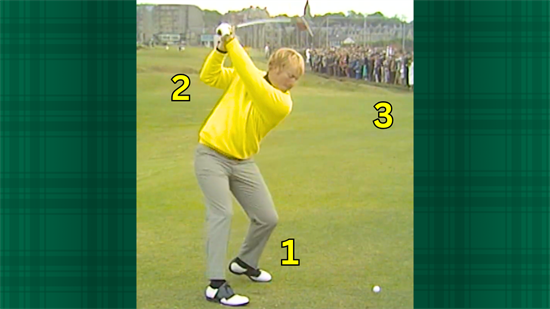
Members of our Arizona private golf club enjoy 36 holes of pristine, Nicklaus Designed golf. In honor of the Golden Bear himself, we tapped Milo Lines – PGA Professional, Golf Digest's Best Teachers In Every State (2026-'27) for Arizona and instructor at Superstition Mountain Golf & Country Club – for some insights into the GOAT’s powerful swing.
Jack's Smooth and Timeless Golf Swing – Yet Full of PowerToday I'll be revealing the three golf swing mechanics that I believe Jack Nicklaus mastered at a young age to become the longest, most dominant force of his era–and arguably the GOAT of our sport. Read along for my full analysis, and I’ll also be sharing with you three equipment-free movements to unlock these powerful mechanics for yourself. Plus, one drill at the end to master them all so you can swing just like the Golden Bear.
Given Mr. Nicklaus' close ties to Superstition Mountain Golf & Country Club, I thought this would be a fun analysis. I've come to distinguish these three mechanics after years of studying his legendary golf swing, and through the secrets he's shared in his own books and video lessons throughout his career (such as Golf My Way, 1983). So, let's dive into Jack's timeless, athletic action!
First, let's take a quick look at the stats. When it came to driving distance, Jack Nicklaus was consistently one of the longest hitters for much of his career. Early in his career, in 1963, he won the long-drive contest at the PGA Championship with a 341-yard poke with an 11-degree wood driver, 32.75-inch Dynamic Edge shaft. IBM recorded driving distance data at 11 PGA Tour events in 1968, and Nicklaus led the Tour at 276 yards with a persimmon driver—an absurd number in the wooden-head era.
To put it in greater perspective, many players from that era have shared their stories, including Lee Trevino who once said in a CBS interview, "I was in awe of watching this guy, I mean he was a mechanic. You know they always talk about Tiger Woods today hitting the ball 300 yards. Let me tell you something, if Jack had that equipment back then, he would have hit it 350!"
There is no doubt that Jack's swing speed and power in his prime gave him a massive advantage through the decades. Clearly every part of his game was world class, but the driver was likely the one thing that stood out–having the ability to grip and rip it while still being deadly accurate. With a career spanning from 1962–2003, he won 73 times on the PGA Tour, and we all know of his record 18 professional major championships. But I've left a few other crazy stats below per PGA Tour records:
- He had 30 PGA Tour titles before turning 30
- He amassed 286 top-10 finishes in 595 starts (48%)
- His total driving stat (which combines your year-end distance ranking and accuracy ranking off the tee) was a PGA Tour best 23 in 1980, when he was 40 years old. For perspective, Rico Hoey led in 2024 at 83; PGA Tour Player of the Year Scottie Scheffler was second at 87.
The first of our three golf swing mechanics that made Jack Nicklaus' move the most powerful in golf was his footwork sequence. Watch any classic clip: he started with a subtle trigger to initiate the takeaway, then wound up unrestricted. His left knee flexed and moved behind the ball, with the left heel lifting fairly high—like a pitcher coiling for a fastball.
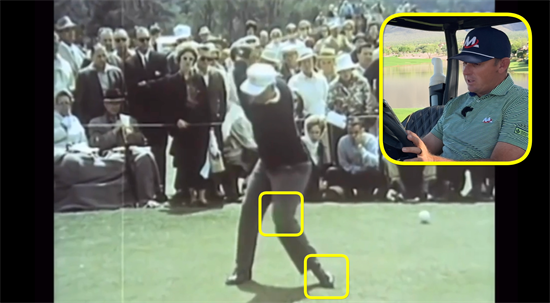
The right foot screwed into the turf, internally rotating the trail hip while keeping slight flex in the knee. This created a lot of torque and load for which he could shift off explosively. Then came the key athletic sequence I always talk about–for me it's the magic move! As the club finished the backswing, Jack then began moving back to the left side for his powerful change of direction. The benefits and subtle positive side effects of this sequence are many, such as: the slight bowed left wrist in transition to shallow the club, the stretch and pull of the arms created by the lead side, and the ability to release the club naturally through the impact position.
This is when he began to replant the lead heel, and importantly, slightly closer to the target so as not to spin out. It’s the same step-and-throw sequence we see in other sports. And now, what's old is becoming new. Modern powerhouses like Bryson DeChambeau copy it: trail heel raising in the backswing, then planting to sling the club through. For a while left foot down was in vogue, but Jack proved athletic freedom wins. He said it himself: “As your swing goes back, your feet are pulled back. As your feet go forward, your feet react with your body.” (from Jack Nicklaus' Golf My Way, 1983)
Your 1st Movement: Dynamic StepsDo this to unlock Jack's powerful footwork sequence. Get in good golf posture and width of stance position, then start with a little side-to-side pressure shift to get going and change foot-to-foot, with heel taps for rhythm.
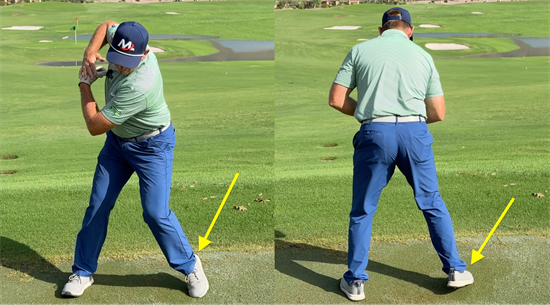
If you are interested to achieve more distance and clubhead speed, I can't overstate enough to start with this little, back-and-forth athletic sequence and grow it! Then grow it with an unweighting of the lead foot and heel as you wind up then plant it back down as to initiate the unwind. Make the movement fluid from one side to the other to change directions easily, and to build a more athletic, natural move!
Mechanic #2: Wide ArcAh yes, the one-piece takeaway, and the flying right elbow. But how did Jack Nicklaus' swing achieve these? The answer is by creating a wide arc! Face-on videos show it instantly—he triggered then slightly squeezed and pushed away the arms, much like Rory McIlroy of today. This instantly widened the first move and synced up his hands and arms with his body.
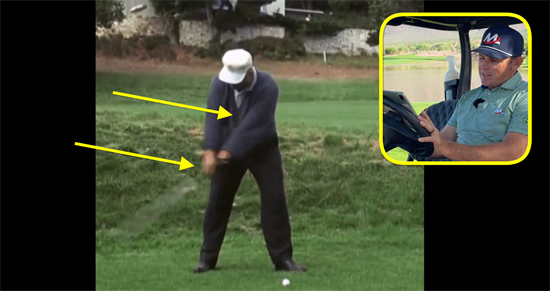
From there Jack's hands could climb sky-high and into position with his windup. Note that he didn't just lift; he was turning in inclination, maintaining his relationship with the golf ball. This wide arc and systematic windup led to his famous "flying right elbow". While some in the golfing world have called this high elbow a sort of swing fault and something to avoid, for maximizing power potential and for ultimate freedom in the swing it's clear this is an optimal move. The wider arc, higher hands position, and big systematic wind up all combine for a power-packed backswing!
Your 2nd Movement: Push the Beach BallGet in your golfing stance and imagine you are holding a beach ball underwater. For this you would longish arms and a slight bit of tension to prevent the ball from popping up. Then make an entire big backswing—maintaining just enough tension to keep structure and the imaginary beach ball well away from you. Then transition into the downswing, through impact position, and move all the way into a dynamite finish with the same structure.
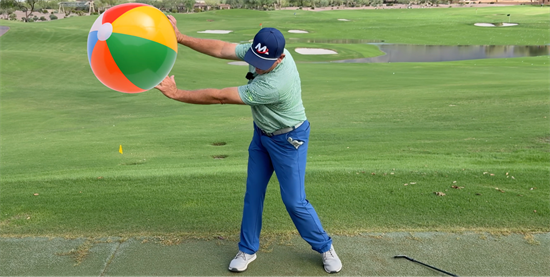
To advance this movement, blend in the dynamic footwork sequence from the first movement: load the trail side, plant, then extend arms fully as you unwind. For this I also like to picture I am tracing a big ring with the palms of my hands. This width and length was a big part to Nicklaus' strength, producing a long lever and runway to increase clubhead speed.
Mechanic #3: Big TurnThe third and final GOAT mechanic: Nicklaus' massive body turn (on both sides). Teenage footage is jaw-dropping—hands six inches above his head, right shoulder rotating fully behind his neck, and his right hip deep and loaded. Overhead views from his professional days confirm a big, big windup with lots of body rotation!
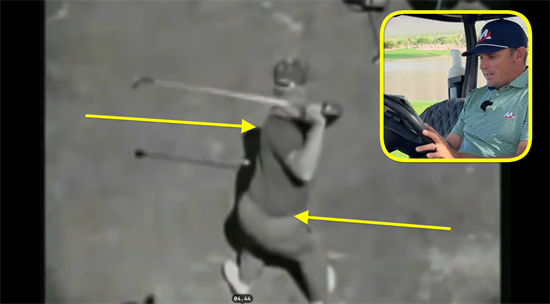
But it's important to note that Nicklaus didn’t just rotate his body; he stretched and wound up dynamically, in bends–or on a plane, with shoulders still angled down towards the golf ball. From there when he unwound, he more-or-less kept this relationship, and freely ripped through the shot, unrestricted without holding anything back. This big, free turn, in angle is essential to not just power and distance, but also efficiency and precise play–all things Jack embodied.
Your 3rd Movement: PropellersThis is one of my favorites and in my opinion one of the simplest exercises any golfer can do right now to improve their golf swing. Start again in your golfing stance and posture. Extend your arms out at your sides parallel to the ground.

Now, wind up on plane with your arms and shoulders pointed slightly outside the golf ball. If you can, go past 90° with your feet free to shift and move like in the first movement. Then land and unwind fully, trying to get a big turn on the front side as well. This builds the coil. Do this one daily and before you play your next round; your swing will feel longer, freer, and more in line!
These Three Golf Swing Mechanics MUST Work Together!These aren’t isolated moves—they’re a system. Footwork loads the ground. Wide arc lengthens the lever. Big turn stretches the spring. Skip one, efficiency and consistency is lost, power leaks, and shots become wayward.
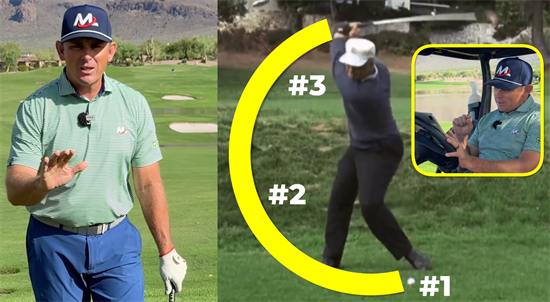
Jack’s genius was blending them into one fluid, athletic motion. That’s why he led the PGA Tour in driving distance while still consistently ranking top-10 in accuracy. Power with control, and a game we're all envious of.
The Golden Bear Drill – Master All Three Mechanics in One SwingAs promised, here's the one drill to tie it all together: The Golden Bear Drill! This golf drill is about reaching new ranges and raising your power potential ceiling. But to start, I'd suggest beginning in slow-motion and off a short tee, with say an 8-iron.
Chip the ball only 30 yards to start, but still with a big, full swing to accentuate these mechanics and grow the motion. Don't worry so much about how, or where you hit the golf ball at first as it may feel a bit wild. The point again is to raise your ceiling and to finally feel Jack's athletic mechanics for yourself. Once you have things working in order and developed the pattern, begin laddering up by 20 yards until you start hitting the ball farther than ever before!
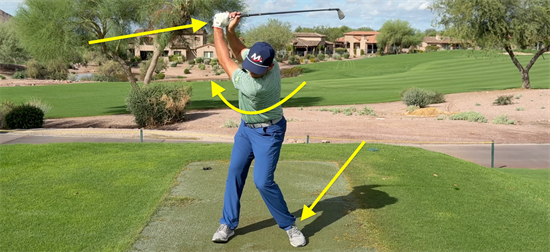
- Make a little side-to-side and subtle footwork sequence, then trigger the takeaway with long arms and a one-piece takeaway just like Jack.
- Wind up systematically to a big, on-plane backswing, with high hands and loaded trail leg and lead heel off the ground.
- As you are completing the windup, drop back slightly to the lead side to plant the lead heel, and unwind through the shot to a big full finish.
Do this for 10–20 swings every warm up and I promise you'll begin to feel the sequence, the freedom in your feet, and the natural release–just like the Golden Bear! So give it a shot, and don't forget, you can watch the full YouTube video I made on all of this, here.
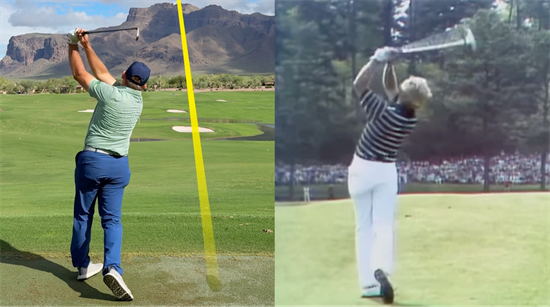
Could Superstition Mountain Golf & Country Club, a Jack Nicklaus Design, in fact be a perfect playground for the exact powerful swing we’ve dissected here? In my opinion, yes! For 36 holes of desert golf, I like to think that both The Prospector and Lost Gold golf courses offer a playable, player-friendly experience but, where distance truly gets rewarded, with 9 par-5s, and several long par 4s and 3s collectively. With numerous forced carries, doglegs available to cutoff, and firm-fast greens, you better believe distance and carry are on your side if you want to take it low!
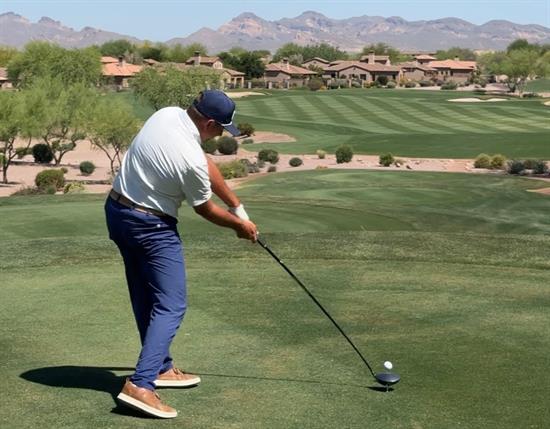
The Prospector and Lost Gold courses at Superstition Mountain were completed in 1998 and 1999, and have consistently been ranked as two of the best golf courses in Arizona, and for good reason. They are fun to play, beautifully maintained, and provide amazing views of the mountain and desert surroundings at every turn. The courses still have plenty of teeth, but make no mistake, these two courses are tailored for the long bombers. And these three mechanics: footwork sequence, a wide arc, and a big turn, will give you the leg up in conquering them just like the great Jack Nicklaus!
Need Help With Your Swing?Reach out to Milo and our amazing staff of golf instructors at Superstition Mountain. For 1-on-1 golf lessons in Arizona direct from Milo, golf schools, and access to his Online Academy for personalized swing analysis and his full swing playbook, head on over to Milo Lines Golf at milolinesgolf.com.
11.15.25


